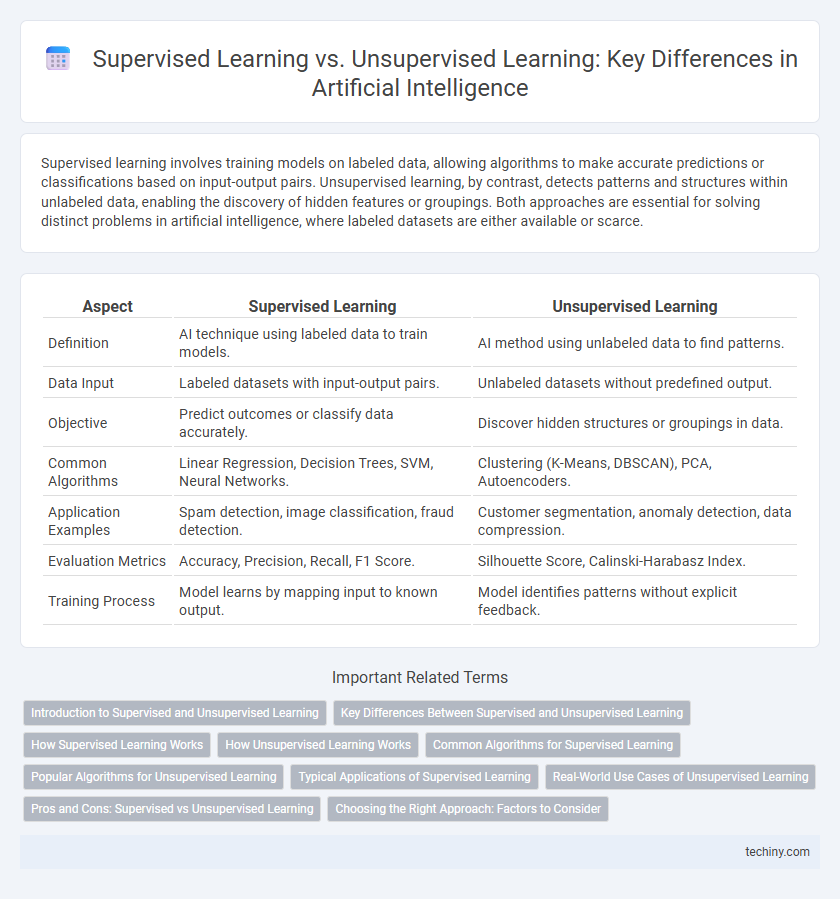Supervised learning involves training models on labeled data, allowing algorithms to make accurate predictions or classifications based on input-output pairs. Unsupervised learning, by contrast, detects patterns and structures within unlabeled data, enabling the discovery of hidden features or groupings. Both approaches are essential for solving distinct problems in artificial intelligence, where labeled datasets are either available or scarce.
Table of Comparison
| Aspect | Supervised Learning | Unsupervised Learning |
|---|---|---|
| Definition | AI technique using labeled data to train models. | AI method using unlabeled data to find patterns. |
| Data Input | Labeled datasets with input-output pairs. | Unlabeled datasets without predefined output. |
| Objective | Predict outcomes or classify data accurately. | Discover hidden structures or groupings in data. |
| Common Algorithms | Linear Regression, Decision Trees, SVM, Neural Networks. | Clustering (K-Means, DBSCAN), PCA, Autoencoders. |
| Application Examples | Spam detection, image classification, fraud detection. | Customer segmentation, anomaly detection, data compression. |
| Evaluation Metrics | Accuracy, Precision, Recall, F1 Score. | Silhouette Score, Calinski-Harabasz Index. |
| Training Process | Model learns by mapping input to known output. | Model identifies patterns without explicit feedback. |
Introduction to Supervised and Unsupervised Learning
Supervised learning involves training algorithms on labeled datasets, enabling models to make predictions or classify data based on input-output pairs. Unsupervised learning, in contrast, processes unlabeled data to identify hidden patterns, structures, or groupings without predefined categories. Key techniques include classification and regression for supervised learning, while clustering and dimensionality reduction are fundamental in unsupervised learning.
Key Differences Between Supervised and Unsupervised Learning
Supervised learning involves training models on labeled datasets where input-output pairs guide accurate predictions, enabling tasks like classification and regression. Unsupervised learning processes unlabeled data to identify hidden patterns and groupings, commonly applied in clustering and dimensionality reduction. The key difference lies in the presence of labeled data for supervised learning, which directs the learning process, whereas unsupervised learning infers structures without explicit guidance.
How Supervised Learning Works
Supervised learning operates by training algorithms on labeled datasets, where each input is paired with a corresponding output, enabling the model to learn the mapping function between them. This method relies on clear feedback through error correction, optimizing performance as the algorithm adjusts weights to minimize prediction errors. Common applications include image classification, speech recognition, and fraud detection, leveraging large, annotated datasets to improve accuracy.
How Unsupervised Learning Works
Unsupervised learning operates by analyzing data without labeled outcomes, identifying inherent patterns, structures, or clusters through algorithms such as k-means clustering and principal component analysis (PCA). This approach leverages methods like autoencoders and generative adversarial networks (GANs) to model data distributions and extract meaningful features from raw inputs. Unlike supervised learning, unsupervised learning optimizes objective functions based solely on input data properties, enabling applications in anomaly detection, customer segmentation, and dimensionality reduction.
Common Algorithms for Supervised Learning
Common algorithms for supervised learning include Decision Trees, Support Vector Machines (SVM), k-Nearest Neighbors (k-NN), and Neural Networks, each optimized for labeled data classification or regression tasks. These algorithms leverage input-output pairs to minimize prediction errors through techniques such as entropy reduction in Decision Trees or margin maximization in SVM. Performance metrics like accuracy, precision, recall, and F1-score critically evaluate the effectiveness of supervised learning models in various AI applications.
Popular Algorithms for Unsupervised Learning
Popular algorithms for unsupervised learning include K-means clustering, which partitions data into distinct groups based on feature similarity, and hierarchical clustering that builds nested clusters through a tree-like structure. Principal Component Analysis (PCA) reduces dimensionality by identifying key components that capture the most variance in data. Additionally, DBSCAN excels at identifying clusters of varying shapes by detecting dense regions separated by low-density noise.
Typical Applications of Supervised Learning
Supervised learning excels in applications such as image recognition, natural language processing, and fraud detection, where labeled datasets guide model training to achieve accurate predictions. It is widely used in spam email filtering, medical diagnosis, and customer sentiment analysis due to its ability to learn from explicit input-output pairs. These applications benefit from continuous improvement as more annotated data becomes available, enhancing model precision and reliability.
Real-World Use Cases of Unsupervised Learning
Unsupervised learning excels in real-world applications such as customer segmentation, anomaly detection, and market basket analysis by identifying hidden patterns without labeled data. Clustering algorithms like K-means enable businesses to group customers based on purchasing behavior, optimizing marketing strategies. Anomaly detection in network security uncovers unauthorized access or fraud, enhancing system reliability and safety.
Pros and Cons: Supervised vs Unsupervised Learning
Supervised learning excels in tasks requiring labeled data, providing high accuracy and clear objective functions, but it demands extensive annotated datasets, making it costly and time-consuming. Unsupervised learning can uncover hidden patterns and structures in unlabeled data, enabling flexibility and discovery without prior knowledge, yet it often yields less precise results and challenges in evaluating outcome quality. Balancing the advantages of interpretability and control in supervised learning with the exploratory power of unsupervised methods is key in selecting the optimal approach for specific AI applications.
Choosing the Right Approach: Factors to Consider
Choosing the right approach between supervised learning and unsupervised learning depends on key factors such as the availability of labeled data, the complexity of the problem, and the specific goals of the AI project. Supervised learning excels when large amounts of labeled datasets are accessible, enabling accurate prediction and classification through algorithms like neural networks and support vector machines. Conversely, unsupervised learning is ideal for exploring underlying data structures without labels, leveraging techniques like clustering and dimensionality reduction to uncover hidden patterns and relationships.
Supervised Learning vs Unsupervised Learning Infographic

 techiny.com
techiny.com